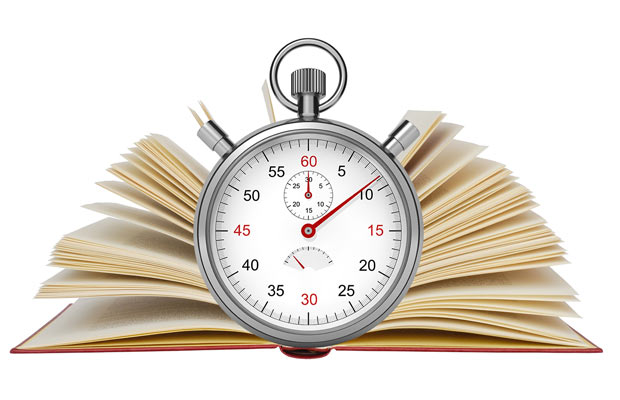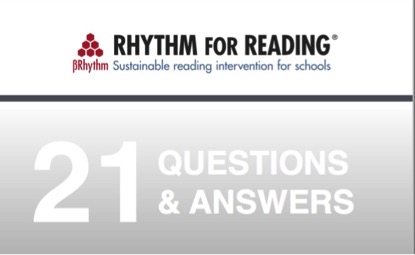The Rhythm for Reading blog
Virtuous spirals
1 October 2016Last month’s post focussed on the expressive aspect of reading fluency, drawing a comparison between the varying trajectories of a ball in a tennis match with the varying contours of sentences in a passage of text. The analogy served (npi) to emphasise the high degree of flexibility and poise required for fluent reading. However, in this post I want to stress the importance of the link between reading fluency and reading comprehension: skilled readers who are able to read with fluency and understanding are swept up into a virtuous spiral, which contributes to a lifelong-love of reading and learning.
There is little point in being able to read quickly, accurately or fluently, if readers cannot process the meaning of a passage. Without the automatic integration of decoding and semantic processing that skilled readers enjoy, weaker readers cannot experience the intrinsically rewarding aspects of reading and benefit from the same virtuous spiral. A wide range of cultural factors such as maternal education, gender, SES and changes in digital technology may disadvantage some children, but it is important to maintain the high expectation that every child can become a skilled reader. Training weak readers to identify in a text the visual match to the key words in a comprehension question and then retrieve the whole sentence without necessarily understanding the text for example, can only serve to degrade their experience of reading and learning.
Readers with poor comprehension skills are limited by their recognition of printed words as ‘signs of language’ that convey sound (phonological processing). Skilled readers on the other hand, recognise words and phrases as ‘signs of real or imagined life’ that convey meaning (phonological and semantic processing, as well as detecting grammatical structure).
Interestingly, the integration of decoding with semantic processing occurs without deliberate effort on the part of skilled readers. Weak readers, however need help with integrating decoding, syntactic and semantic processing. This can be achieved by improving their sensitivity to rhythm in a matter of weeks. Rhythmic awareness is integral to the way we breath, eat, laugh, speak and move and can be extended to reading too. Read more here.

Considering reading fluency
1 September 2016 
Earlier this year, we started to measure our impact in a slightly different way. Many teachers and head teachers have remarked on the improvement in their pupils’ reading fluency, so it seemed important to try to capture what has been happening. Of course, there are different ways to define and to measure reading fluency, but here is a snapshot of what we found when using two types of assessment. Luke (not his real name) aged 11, attends an outstanding school in the East of England and according to the school’s tracking data in December 2015, his reading age was 8 years, 3 months, which was broadly in line with our baseline reading rate score using the Neale Analysis of Reading Ability (NARA II).
Luke has a SEND diagnosis, and he participated in the Rhythm for Reading sessions with unwavering commitment. Although he was quite a bit younger, he quickly became the leader of a group of adolescent boys all of whom struggled with attainment across the curriculum. Luke’s teacher observed all of the sessions. She was amazed by his confident approach and said that this was a side of him that the staff at school had not seen before.
The ten sessions of the programme ended in March 2016. Luke had gained 7 months in reading fluency (AAB)* and 35 months in sentence comprehension (AAB). His scores on the NARA II showed a gain of 13 months in accuracy, 8 months in comprehension and 38 months in rate of reading.
Luke’s teacher observed his classwork and filled in a tick box survey, comparing his recent progress during the programme with his usual rate of progress. During the period from January to March 2016, his teacher observed that he’d made better progress than usual in using punctuation, understanding texts, participating in class and in his attitude towards reading.
In March, I asked Luke whether or not he’d noticed a change in his reading since we started the programme. He replied, “It’s helped me with my reading and my eye focussing and my concentrating.” When I asked him how that made him feel, his response was heartfelt,
It makes me feel better. It makes me want to read more. I never wanted to read. I never used to read. Now I love reading.
Hearing Luke read expressively and effortlessly on that day was wonderful, but to hear him proclaim his enjoyment of reading was such a privilege. I heard from his teacher at the end of June that all of the boys who had taken part had maintained their progress.
*You might be wondering what the AAB is. The Academic Achievement Battery (AAB), constructed by Melissa Messer, was published in 2014 by PAR. The AAB is suitable for children and adults (4 - 85 years) and offers 15 subtests in reading, writing, spelling and arithmetic. There are two similarities between the sentence comprehension test from the AAB and reading comprehension as assessed by the Neale Analysis of Reading Ability (2nd British Edition), published by GL Assessment. Both tests assess comprehension while the pupil has the text in front of them. In other words, they are not being assessed on their capacity to remember the text. Like the NARA II, illustrations are an integral part of the AAB test, increasing the appeal of the format for reluctant readers with fragile word recognition skills. The AAB measures reading fluency as the number of correct words read in one minute. The obvious advantage of this approach is that it is quick and easy to use. However, it is not designed to capture the positive changes in expression and engagement with reading that we have become accustomed to hearing. More on this next time!
NATE 2016
1 July 2016The National Association for the Teaching of English 2016 Conference began on the 24th June, the day that the referendum result was announced and closed on 25th June with a witty and poignant keynote from the wonderful Children’s Laureate (aka Launderette) Chris Riddell and plenty of laughter from delighted delegates. Simply being among so many positive people at a time of immense change really underlined the value of high quality events such as this one. Now is the time to adapt and plan for the likely changes that lie ahead; we absolutely must make sure that every child and young person learns in a safe and inclusive atmosphere.
How is it possible to achieve so much more when resources are already stretched and budgets are constrained? Here are a few ideas based on reflections from NATE 2016. Make sure that….
1. Every child is able to access the curriculum. It may be challenging to offer continuous speech and language support or EAL support because of budget constraints, but please consider investing in local, flexible, qualified, competitively priced, self-employed specialists.
2. Every child can see and can hear well enough to learn. Every year I meet a small number of children who struggle with reading because of poor eyesight or hearing. Sometimes, the problem is known, but has not been addressed – please find and prioritise these children and young people.
3. Every word matters. The eloquence and articulacy of the speakers and the delegates at NATE reminded me that our thoughts and words are among our sharpest tools and that we build our communities through language. The impact of language is immediate. By finding extraordinary words that are not only appropriate to the situation, but also are more imaginative, or more precise, or more motivational, or more compassionate than usual, we are better equipped to manage new situations and the challenges of changing situations.
4. Every decision is a positive decision. By resisting the opportunity to teach the same text in consecutive years, by choosing not to opt for the shortest text as a way to save time in the next academic year, we make decisions that will enrich rather than degrade every working day of the year ahead.
5. Every classroom community is friendlier, safer and stronger. Music is the social superglue of human evolution; it is remarkable in building social cohesion out of thin air and like superglue, a little goes a very long way. Looking forward to next time…
Please browse the website to find out how music and language can work together to promote reading and learning.
“What does the science tell us? What does the research say?”
1 June 2016As a necessary part of due diligence, school leaders must ask probing questions before committing to an intervention and research is an important source of information. In previous posts, I’ve highlighted academic work that explores for example, the importance of rhythm in infant language learning (October, 2015), the development of reading skills (March, 2015) and language processing in the auditory brainstem (November 2015).
It’s important to consider the extent to which school leaders can have confidence in the rigour of scholarly work and peer-review. A peer-review panel made up of academics with specialism in a particular field is uniquely qualified to judge that an article is not only relevant to the readership and methodologically sound, but also meets the ethical and academic standards of the publication. Many journals now offer free access to high quality, peer-reviewed content considered to be relevant to a wider readership (e.g. Long, 2014).
Incredibly, more than 5,000 academic papers are published each year in journals on the role of shared or overlapping neural structures known to contribute to linguistic processing and musical processing. Although many people intuitively believe that it may be possible to isolate and identify a ‘single mechanism’ that might explain the overlap between language and music, it is becoming more likely that several interconnected mechanisms or networks may be involved (e.g. Peretz et al., 2015).
When pupils in key stage one, key stage two and key stage three have taken part in the Rhythm for Reading programme, they’ve described benefits to their reading, concentration and attitudes to learning, suggesting that the impact of the programme is fairly broad. Recent research with older pupils in a special school has also demonstrated clear benefits of the programme on reading attainment and other areas of learning behaviour.
Consultation meetings with school leaders have sparked interesting discussions, with particularly popular topics which come up again and again.
1. The structure and content of the Rhythm for Reading programme.
2. The ‘single mechanism’ that might explain how the programme works.
3. The suitability of the intervention for different groups of children, for example pupils identified with EAL or SEND or FSM.
4. Professional development.
5. The development of the Rhythm for Reading programme.
As these are really popular questions, I’ve made a useful free resource for school leaders, please click here to have a read.

References
Marion Long. ‘I can read further and there’s more meaning while I read’: An exploratory study investigating the impact of a rhythm-based music intervention on children’s reading. Research Studies in Music Education (2014): 1321103X14528453.
Peretz, Isabelle, et al. “Neural overlap in processing music and speech.” Philosophical Transactions of the Royal Society of London B: Biological Sciences 370.1664 (2015): 20140090.
Creativity, constraints and accountability
1 May 2016Creativity is in us all. Our creative impulse generates streams of language, songs, gardens, new recipes based on what’s in the fridge and spontaneously occurring ideas. There is a playfulness in the ‘what if …’ process which guides the initial impulse into something more considered, more useful, more committed. Shaping and honing lead to rapid iterations of the initial idea. A sense of expectancy and involvement builds as the creative process gains momentum.
Imagine a group of children aged nine years who have fallen many years behind their classmates and cannot maintain their attention for even five seconds, but they are highly motivated to learn to play a musical instrument. Imagine their confident teacher, who spent 20 minutes of a half hour lesson trying to find a task that engaged them, but had failed to teach them anything at all.
As the teacher inwardly acknowledged the failure of the lesson, the children visibly braced themselves for harsh words. The atmosphere in the room was hushed and expectant. What happened next? The teacher looked for the path of least resistance asking, “What do you do after school?” They loved to play football and the teacher quickly discovered that they were better able to learn when they moved their feet.
This approach was unorthodox, but justifiable because the children’s self-control and self-awareness was far better practised in football skills than in anything else. Some months later, their progress in music had been excellent and their classwork had transformed. They were showcased by their headteacher: playing as a group and individually in full school assembly in the presence of Ofsted inspectors and invited to join the school orchestra immediately afterwards.
Here’s the take away message. The four conditions that ensured the lasting success of this approach point to the importance of outrageous levels of optimism in a school (judged to be outstanding).
1. The children wanted to learn to play a musical instrument.
2. Their class teacher saw this as an important opportunity for them.
3. The headteacher placed a high value on music in the school.
4. The continuity of weekly lessons in a suitable room meant that the creative process evolved without interruption.
Practising Poetry - the importance of rhythm for detecting grammatical structures
1 April 2016There are so many overlaps between poetry and music. People ask me frequently why it is that reciting poetry seems to help children, particularly those finding aspects of reading fluency and comprehension somewhat challenging.
Practising poetry by heart, particularly in group teaching is a massively experiential process. The feeling of the sounds in the movement of the face, the jaw and the tongue are dance-like sequences and enjoyed for their bold sensations, which in terms of conveying their mood, colourful tones and timbres are musical in every way. In terms of how it feels, reciting poetry is just like practising a musical instrument; indeed practising poetry through the congruence of movement, sounds and patterns is a deep and enriched form of language learning that we all can enjoy, having mastered this first as infants acquiring our mother-tongue (Nazzi et al., 1998).
If you read aloud or recite Lewis Carroll’s Jabberwocky, it’s easy to evoke the atmosphere and moods created by movement, rhythm and sound, even though the words of the poem are meaningless. Behind the expressive tones of the nonsense words, there’s a robust rhythmical structure and fascinatingly, researchers have found that we respond to the poem as if to a projected illusion of grammatical structure (Bonhage et al., 2015). The importance of rhythmical patterns is that they cast beams of expectation, helping to guide and focus our attention, enabling us to fully anticipate and enjoy all the more, the likely flow of the sounds and the colourful moods of the poem.
The usefulness of rhyme, so popular in children’s literature, is that it offers a fun and playfully supportive, highly accessible and very basic form of phonological awareness. Hearing the rhyming feature in words is a massive anchor for children who may arrive at school struggling to discern word boundaries in a stream of speech. This example of rhyme is from, ‘One fish, two fish, red fish, blue fish by Dr Seuss (1960):
This one has a little star. This one has a little car. Say! what a lot of fish there are.
Rhyming words are also invaluable for those children who come to school with a clearer grasp of language. Children are stimulated by rhymes, because rather than simply following the language of the poem, they are more deliberately focussing their attention in order to predict the placing of the rhyming word at the end of the line or phrase. For these reasons it is not surprising that highly rhythmically aware children are more likely to become good readers (Tierney and Kraus, 2013) – they arrive at school able to anticipate and enjoy the structure of rhythmic patterns in language. Similarly, children who may require a reading intervention thrive when practising poetry because the explicit rhythmical structure and shorter phrase lengths support their attention, helping them to perceive the meaningful elements of language more easily.
In the Rhythm for Reading programme, we takes this principle further still, by providing rhythm-based reading tasks that give the children a chance to build their awareness of rhythmic patterns very rapidly. The sessions are a highly condensed extraction from traditional musical training. Building a strong response to rhythmical patterns, children develop and sustain their attention across increasingly complex musical phrases. Their awareness of rhythm transfers into their reading development after only a few ten-minute sessions.
If you liked this blog post, you are invited to subscribe to my weekly updates for interesting insights into rhythm, language and learning.
Bonhage, Corinna E., et al. (2015) “Combined eye tracking and fMRI reveals neural basis of linguistic predictions during sentence comprehension.” Cortex 68, 33-45
Dr Seuss (1960) One fish two fish red fish blue fish, Random House
Nazzi, T., Bertoncini, J. and Mehler, J. (1998). Language discrimination by newborns: Towards an understanding of the role of rhythm, Journal of Experimental Psychology: Human Perception and Performance, 24, 756-766
Tierney A, Kraus N (2013) Music training for the development of reading skills. Prog Brain Res 207:209 –241

Ears, Eyes, Voices and Early Reading
1 March 2016When did you last feel your ears ‘pop’ and lose the sound of your own voice?
Like many people, this happens to me fairly frequently on flights and car journeys. Adapting to the muffled world of partial hearing is quite intriguing as it offers a rare glimpse into what my brain is doing behind the scenes while I’m having a simple conversation. Of course, I’m always extremely grateful when my hearing returns to normal again.
Our awareness of speech is organised for the most part around our perception of sound, which is probably why our awareness of the rapidly changing jaw movements or the movements of facial muscle groups is suppressed while we are speaking. Consequently, losing the sound of our own voice is extremely disruptive to normal speech production.
If like me you’ve tried to persevere with a conversation in the absence of sound perception, you may have experienced that the movement sensations produced by facial muscles and jaw muscles are no longer suppressed, but that you become aware that your perception of your facial muscles is magnified, revealing in detail the intricate facial shapes necessary for the formation of syllables and words.
Even though the power of speech feels far slower and more effortful in the absence of sound, it’s still possible to continue speaking by monitoring the rhythmic patterning of the jaw and the facial muscles. In this way, rhythm unifies intention and movement in language, overriding the temporary disruption to the auditory system.
Losing the sound of my own voice made me realise how tiring communication can become if the sounds of language are not clearly relayed from the voice to the auditory system. It also indicated the importance of the role of rhythm as a bidirectional frame both for anticipating and tracking the number of syllables produced in an utterance.

The development of early reading depends on the efficient coordination between the ear and the eye. Strong associations between letters and their sounds help children to learn to recognise words on the page. Voices matter too. Educators have realised that poor oral language skills are a strong predictor of poor literacy (Stackhouse & Well, 1997) and that socially disadvantaged children are more likely to lag behind in their vocabulary development when compared with more affluent peers (Fernauld et al, 2013) and require a reading intervention. Indeed, research indicates that sharpening rhythmic awareness supports children’s ability to process information (Long, 2016), better perceive the sounds of language, to read more fluently and with more understanding (Long, 2014).
If this interests you, why not dip into the case studies and sign up for the Rhythm for Reading programme weekly updates.
Fernald, A, Marksman, A & Weisleder, A (2013) SES differences in language processing skill and vocabulary are evident at 18 months. Developmental science 16, (2) pp. 234-248.
Long, M. (2016) Rhythm for Reading, English 4-11, 56, pp. 5-6
Long, M. (2014) “I can read further and there’s more meaning while I read” An exploratory study investigating the impact of a rhythm-based music intervention on children’s reading Research Studies in Music Education, vol. 36, no. 1, pp.107-124
Stackhouse, J. & Well, B. (1997) Children’s Speech and Literacy Difficulties: A psycholinguistic framework. London: Whurr.
Confidence and happiness in the Rhythm for Reading programme
1 February 2016
This post describes the tenth of ten Rhythm for Reading programme sessions. By this stage in the reading intervention, everyone in the group can sight-read both simple and comparatively complex music notation with ease and confidence. To do this, our eyes are glued onto the board, our voices are synchronised and we’ve gelled through teamwork. The important part is this: the group experiences music at a deeper, more interpersonal level when these skills become reliable and relaxed, even when facing more challenging tasks. Here’s a short description of how this felt in the final session of the programme and a quick drill down into the concept.
After a couple of minutes, everyone’s behaviour changed at the same time. There was a sharp increase in the level of congruence in the group. Standing calmly as the task ended, they waited and gladly repeated the experience, expanding even more fully into the sounds they were creating. This level of working was maintained consistently for a further eight minutes, after which the group left the room feeling energised and calm, returning cheerfully to class.
These words have been carefully chosen to describe as accurately as possible how working in this way with the rhythm-based elements of music makes a difference to emotional well-being. Congruence in this sense refers to the sheer strength and coherence of our perception of rhythmic patterns, particularly when working as a group. Gains in reading behaviour can be measured, but the more profound benefits to wellbeing such as the increase in confidence and happiness that many children describe, are not measurable in this or any form of group teaching.
This rather reminds me of psychologist Mihaly Csikszentmihalyi’s work on ‘flow’ or ‘optimal experience’. Optimal experiences are life-affirming, intrinsically rewarding and in terms of pedagogy, they are highly desirable because they boost students’ confidence and motivation. They can be very helpful in realigning attitudes towards reward, so that students become motivated by the sheer joy of taking part rather than wanting to know what they will ‘get’ in return for taking part.
The spontaneous element of what I have described is not trivial, but extremely important, as it describes how the deeper and more satisfying levels of engagement can be achieved through working in this way. Perhaps it is our irrepressible ability to generate congruence from patterns in music and language that fuels our joy of reading and of music making.
Find out more here
Reference
Csikszentmihalyi, M. (2002) ‘Flow: The classic work on how to achieve happiness’ Rider, Random House, ISBN 9780712657594
